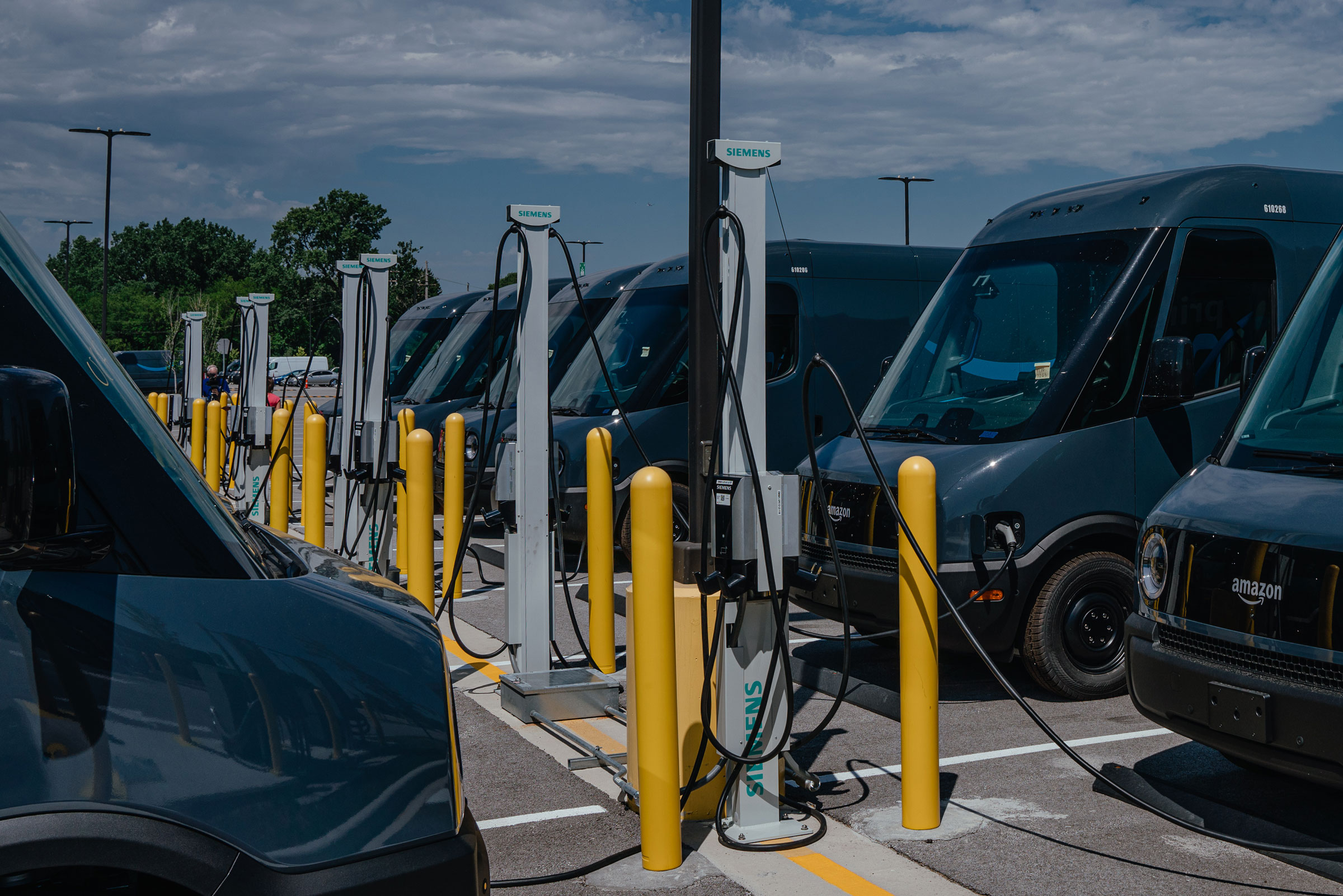How Amazon Became World’s Largest Buyer of Renewable Energy

WCarson Harkrader, hen Richard, and Carson Harkrader heard about 696 acres North Carolina farmland up for sale in 2016. In 2016, one particular feature caught their attention. It was the lines of power that ran across the land as though somebody had dog-eared it. Hard up against the Virginia border, it was a pretty spot—pretty enough that a home builder would eventually take a quarter of the acres for a lakefront subdivision. The Harkraders were father and daughter operators of Carolina Solar Energy. This independent developer of solar energy projects was the best. Their heavy-duty transmission cables arced northwest to join the PJM Interconnection.
“It was kind of a gold rush,” the elder Harkrader says one morning this summer, standing amid the hundreds of thousands of glistening black panels, now known as Hawtree Creek Solar Farm, that follow the curve of the hills and tower over our heads. At midmorning, the panels have sent 34 megawatts of power out to the grid. This is roughly the equivalent of 10,000 home generators all at once. By noon, it’s 65 megawatts—the maximum the grid will take. “I still think it’s magic,” Harkrader says. “Take sunlight and … boom!” Except the only noise is the occasional creaking of their steel frames, as small motors tilt the panels to follow the arc of the sun across the Carolina sky.
About 200 miles north, in Virginia, are the eager buyers of that electric gold: the mega-technology companies, like Amazon, Microsoft, and Google, that operate giant data centers essential to our daily lives, whether we’re ordering on Prime or backing up family photos. Under pressure from customers, employees, and shareholders—and, arguably, out of their own eagerness to reduce emissions—they have been increasingly determined to run these data centers on renewable energy. Once the Harkraders had secured the new solar farm’s preliminary permits and permissions—making a plan to accommodate local deer and joining the crowded “interconnection queue” to plug into the grid—they leased the land to Engie, a French energy giant that builds and operates more than 4,500 megawatts of solar power around the world. And then, before the panels had even arrived on site for installation, Engie in turn struck a deal to sell all the site’s power to a single company: Amazon.
That financial and legal arrangement, known as a PPA (power purchase agreement), has been a crucial force in the U.S.’s transition to clean energy. Of the approximately 235 gigawatts of wind and solar capacity now installed on the nation’s grid, nearly one quarter (more than 52 gigawatts) has been contracted by corporations, mostly over the past decade. That vigorous—and notably voluntary—corporate action has boosted a web of wind and solar manufacturers, developers, and operators. The cost of renewables has been made more competitive and grid operators have learned to deal with greater variability.
PPA made the renewables market as popular as modern mortgages. It bridges the economic needs of renewable–energy developers with the climate goals of corporate executives and shareholders. Solar panels and wind turbines are expensive to build but cheap to operate, given that their fuel—sunlight and fresh air—are free. By guaranteeing the electricity will be sold long before it’s been generated, a PPA gives banks confidence to front the money for construction—especially when there’s a giant corporation guaranteeing the deal. In the way that power grids work, all that electricity isn’t wired directly to these companies’ facilities, but adds more juice to each region as a whole. But the way that PPAs work means the companies can legitimately argue that these giant renewable projects wouldn’t have happened without them. PPAs stitch together developers like the Harkraders, energy operators like Engie, electric grids like PJM, and—above all—the large companies hungry for power from renewable sources.

Amazon delivery trucks wait in line to get into the Amazon DAX3 station at Chatsworth on January 12, 2022.
ROGER KISBY—REDUX
This was the largest ever corporate power purchaseAmazon is using that network to purchase 15.7 gigawatts worldwide over the past 3 years. That’s almost equal to its $1.4 billion energy requirements. Like an early shopper on Black Friday, Amazon’s fervor has been felt across the industry—while also giving a glimpse of the incredible growth still to come, with the arrival of $369 billion in federal funds provided by the Inflation Reduction Act (IRA). This key driver has been the driving force behind the last decade’s solar and wind developments helps us to see the future. A record-breaking boom in renewable energy could be a major wedge in the larger effort to cut carbon emissions and reduce the temperature rise.
“If it was a market that only waited till something was built—and then you went out and tried to sell the -electricity—these projects wouldn’t get done,” says Harkrader. “People like Amazon, or Microsoft, Walmart, Target—on and on—are standing up and making this market possible. And it’s exploding.”
Amazon is currently the most hungry of all. While Amazon was not first to purchase renewable power, it now buys the most. It has revealed plans that are roughly equivalent to 250 additional Hawtree Creeks and about equal to the total amount of solar power built in America last year. The buying spree is part of Amazon’s broader effort to reach “net-zero carbon” by 2040—meaning it will eliminate or offset the carbon emissions from all its operations, including trucks, planes, and manufacturing. That won’t be easy. Amazon Prime members account for approximately two thirds of American homes. Without accessing the Amazon data centers, it’s nearly impossible to use internet. Since it announced its climate goal in 2019, Amazon’s emissions have grown 40%—as its sales have grown more than 50%. “The path to achieving some of our goals will be long and complex,” acknowledges Kara Hurst, who leads Amazon’s sustainability efforts. But clean electricity is Amazon’s climate bright spot. With today’s technology—and a fat checkbook—the company has nearly eliminated its use of dirty energy, prioritizing the hard realities of glass and steel over tree planting or tricky accounting, building at a scale that rivals that of many countries. Amazon is now a top corporate buyer, having contracted last year for twice as much as Microsoft.
Learn More: Green Investments and Climate Devastation Are Creating the Future
PPAs are the best way to achieve this feat in the absence major climate legislation. But the IRA—the most substantial piece of climate-focused legislation the U.S. has seen—takes that progress and adds billions of dollars in federal incentives. “It supercharges both the role and the potential for customers to drive even more of this,” says Brynn Baker, senior director at the Clean Energy Buyers Association. According to the latest forecasts, these numbers are staggering. Solar developers expect to install more than 215 gigawatts of capacity over the next five years—40% more than was expected before the IRA, according to a report from the Solar Energy Industries Association and Wood Mackenzie.
Electricity is just one of many carbon emissions. It will therefore not contribute to the Paris Agreement’s goals for climate change. The hope is that the paths established by renewable energy can be applied to harder-to-decarbonize segments, like electric vehicles and manufacturing. Amazon for instance has stated plans to build 100,000 electric delivery trucks by 2030. “I think we could see even faster progress on transportation than we’ve seen with clean energy on the grid,” says Bill Weihl, executive director of Climate Voice and a former director of sustainability at Facebook. The narrow road that must be paved to make corporate renewable energy purchasing a highway can be seen in the area of corporate power purchase.
Hawtree Creek was a subject that required much attention from the Harkraders for many years. to bring to fruition: attending county planning meetings, mapping wetlands, and exploring an old cemetery that, in the end, couldn’t be moved (the solar panels wrap around it). But for Charlie Daitch, who spearheads Amazon’s renewable-power purchasing, Hawtree was one row on a very tall spreadsheet. “I have a pretty good map in my head of the portfolio—where are we distributed, maybe not each individual project,” Daitch says from the passenger seat of a rented SUV, barreling across North Carolina, on his first visit to the site. “It’s gotten bigger than that.”

Rivian Automotive built the Amazon Delivery Electric Vans (EV) and parked them at stations outside of Chicago’s Amazon Logistics Warehouse in Chicago, Illinois, on Thursday, July 21st, 2022. Amazon Inc. will begin delivery to US customers with the 100,000th electric van built by Rivian Automobile Inc. The company aims to turn over many thousands more of these vehicles in the coming year.
JAMIE KELTER DAVIS—BLOOMBERG/GETTY IMAGES
When Amazon announced the “Climate Pledge” in 2019, it set its own target for reaching net-zero carbon emissions by 2040, 10 years ahead of the Paris Agreement. An earlier goal was also included in the pledge: 100% renewable energy by 2030. Amazon has an extensive network of infrastructure that allows it to move goods across the globe. It is therefore a difficult task to eliminate emissions. It will take years to see sustainable aviation fuel, and heavy-duty electric vehicles, widespread adoption. Wind and solar power, however, are available now. “Renewables is a place we identified where we could go fast to decarbonize our electricity stack,” adds Daitch, a mechanical engineer by training.
Amazon was late in recognizing this fact, compared to its rivals. Walmart announced the first-ever “utility scale” PPA in 2008, with a 153-megawatt wind farm in Texas. It was controversial at the time. “Those early companies that made these commitments did not do so because customers were asking for it,” says Miranda Ballentine, who led Walmart’s sustainability efforts at the time and is now CEO of the Clean Energy Buyers Association. In 2010, corporate trends changed. Greenpeace called the tech companies responsible for their high energy usage in March 2010. Their report was perfectly timed, coming just days before the first iPad was released—a device that self-evidently depended on the internet behind it. Technology companies quickly stepped in to defend themselves. “There is no such thing as a coal-powered data center,” insisted Facebook in a statement. “Every data center plugs into the grid offered by their utility or power provider.” Dirty energy, in other words, wasn’t their problem—it was the grid’s problem.
That half-shrug emoji of an argument didn’t last long. The next year, in a joint statement with Greenpeace, Facebook announced a new “preference” for “clean and renewable” energy. In the following years, other tech titans followed their lead. The idea of putting solar panels on the roof and wind turbines at the lot is not enough. Data centers use too much power, sometimes hundreds of megawatts. Large corporations can use renewable energy through power purchase agreements. They don’t have to wait to get utilities. “Large off-site power purchase agreements remain the tool that allows you to move more quickly,” says Erin Decker, a consultant at Schneider Electric, one of the leading clean-energy advisers. Big Tech firms are happy to make long-term deals—especially if they can send out a press release. Corporate climate action logic dictates that any solar farm built in the middle of the desert must produce sound.
“When we think about our renewable-energy strategy, we’re like, ‘Well, how can we tell the most credible story to our customers about what we’re doing?’” says Amazon’s Nat Sahlstrom. “We don’t want to be greenwashing. We don’t want to be chasing investments that aren’t really having an impact.”
Most of Amazon’s competitors have already completed the deals that lock them into a decade or more of renewable power. Facebook, now known as Meta, long ago “unfriended coal” and has 7.5 gigawatts of renewables under contract. Google reached 100% renewable electricity in 2017, with over 7 gigawatts procured; its next effort is ensuring its data centers run “24/7” carbon-free, meaning all of its energy all the time comes from renewable sources, rather than, for example, buying excess solar during the day to make up for coal power it needs at night. Apple announced that it had sourced 100% renewable energy for its operations in 2018, with 87% of that in the form of PPAs; the next, far more challenging step is helping its suppliers and manufacturers do the same—a goal it has set for 2030. Microsoft owns nearly 8 gigawatts (5.8 of them bought in 2021).
Larger companies are still behind in tech. “It’s not just Big Tech companies,” says Tyler Espinoza at 3Degrees, a climate-action consultancy. “You have a broad swath of massive corporations that are willing to put their money behind it.” In 2021, Pfizer announced a 15-year contract for 310 megawatts of electricity from a Texas wind farm, enough to power 100% of its North American operations—a gigantic leap from the mere 6% of its global usage previously met by renewables. Ford and a Michigan utility signed an agreement for 650 megawatts solar in August.
PPAs can prove difficult to manage for smaller and mid-sized businesses. “The power purchase agreement is a wonderful tool for large, fairly sophisticated, high–creditworthy companies to be able to procure clean energy,” says Ballentine, of the Clean Energy Buyers Association. “It is not as easy of a tool for smaller companies.” As long as there are still large corporations eager to sweep up the available inventory of projects, that hasn’t been a great concern. In the first half of 2022, corporations contracted for 9.8 gigawatts of renewable power in the U.S.—a third of which was Amazon’s.
The challenge, however, is common across the board.It is amazing how important the purchase of renewable energy can have on the wider effort to combat climate change. Ballentine, who was in the trenches for Walmart’s early actions, sees a single-mindedness in these corporate actions. “The big ‘why’ is very simple,” she says. “It’s about solving the climate crisis. There is no other reason that a company would set a voluntary zero-carbon energy procurement goal or renewable-energy goal.”
Even on a global scale, Amazon’s efforts stand out. The company’s initial Climate Pledge called for 100% renewable energy by 2030. The pace changed when Daitch, his team, and others realized that the company could be much more agile than it was. Yet other aspects of Amazon’s business—like all those trucks and planes—were not going to decarbonize anytime soon.

On the plot of 526 acres at Hawtree Creek North Carolina, solar panels are installed
Will Warasila to TIME
Amazon purchased approximately one gigawatt worth of renewable energy in that time. Daitch, who got his start at a traditional energy utility in the Pacific Northwest, working on distribution planning, increased the intensity of his team’s search. The criteria they used varied. In Kansas, wind may be better than in Ohio. As some regions rely heavily on coal power it can make any renewables more impactful. But others had crowded—or dysfunctional—processes for connecting new projects to the grid. Generally, Hawtree Creek is emblematic of how the process often works: a local developer who really knows the geography of the state, its electric-transmission network, and the local politics of its counties might respond to Amazon’s solicitation. Once things get under control, the local developer will hand over the project to Engie, a major energy company.
Amazon made a huge purchase at the end 2021: it purchased 18 projects in different countries around the globe, making them the biggest corporate purchasers of renewable energy worldwide. Amazon added 3.5 additional gigawatts to its total in April. Amazon’s projects dot the map. Two wind farms in Kansas produce over 500 megawatts. They were completed in 2021. There are also four other similar-sized solar plants in Halifax County (Virginia), 65 miles west Hawtree Creek. These farms produce 261 Megawatts more energy. In Ohio, more than 2,000 megawatts have been completed or are coming soon—and on, across 134 utility-scale projects in 15 countries. “There’s a flywheel,” says Daitch. “Our commitment, and signal to the market that we are moving at scale, then gets developers ramped up developing more projects. This encourages solar producers to invest in additional plants and increase production. So there’s that feedback loop.”
As the industry has struggled to keep up with increasing prices and limited supplies, this presumption was tested. Making matters worse, in April 2022 solar development ground to nearly a complete halt when the Commerce Department announced an investigation into Chinese companies violating tariffs—raising the threat of retroactive import taxes on even the modules that were already in the U.S. Then in June, the situation reversed, when the Biden Administration invoked the Defense Production Act to increase solar production. Climate activists felt giddy by the time analysts had completed calculating the impact on the investment made through the IRA. Wood Mackenzie analysts predict that renewable energy investment will total $1.2 trillion by 2035. In a look at the manufacturing of solar polysilicon, the key component in new panels, Bloomberg-NEF found that by 2025 global capacity will be enough to manufacture 940 gigawatts of panels annually—almost as much as the total 971 gigawatts of solar currently installed around the world.
Both individuals and corporations can achieve the same goal: to decrease emissions sufficient to mitigate the impact of climate change. According to an analysis by the International Energy Agency, that means—at least—reaching global net-zero emissions by 2050, on a path that is “narrow but still achievable.” For the past decade, that has looked, frankly, improbable—at least at the pace corporations were going. The United States now has a chance with the IRA.
Blum was the author Tubes The Weather Machine
Read More From Time
Read More From Time





